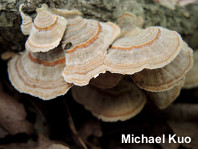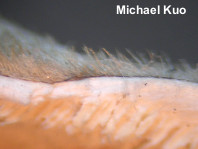| Major Groups > Polypores > Trametes versicolor |

|
Trametes versicolor [ Basidiomycetes > Polyporales > Polyporaceae > Trametes . . . ] by Michael Kuo Trametes versicolor, often called the "turkey tail," has the dubious distinction of being the only member of the forest fungal fowl community not named for the full bird, but a feathery fraction. However, the chicken of the woods and the hen of the woods look nothing at all like chickens or hens, while the turkey tail does look (vaguely) like a turkey's tail. Who started this clucking menagerie of mushroom monikers, anyway? Was Old MacDonald a mycologist? Trametes versicolor is one of the most common mushrooms in North American woods, found virtually anywhere there are dead hardwood logs and stumps to decompose—and, occasionally, on conifer wood too. Its cap colors are extremely variable, but tend to stay in the buff, brown, cinnamon, and reddish brown range. The mushrooms are strikingly "zonate" with sharply contrasting concentric zones of color, and the surface of the cap is finely fuzzy or velvety. Often the zones represent contrasts in texture as well as color, so that fuzzy zones alternate with smoother ones. A number of similar polypores, and even a few species of crust fungi, look more or less identical to the casual eye, and a whole host of mushrooms are thus lumped together as "turkey tails" by collectors who are more interested in gilled mushrooms and boletes. But if you are one of those folks, like me, who just has to be sure, I offer the Totally True Turkey Tail Test, below. Totally True Turkey Tail Test 1) Is the pore surface a real pore surface? Like, can you see actual pores?
No: See Stereum ostrea and other crust fungi. 2) Squint real hard. Would you say there are about 1–3 pores per millimeter (which would make them fairly easy to see), or about 3–8 pores per millimeter (which would make them very tiny)?
1–3 per mm: See several other species of Trametes. 3) Is the cap conspicuously fuzzy, velvety, or finely hairy (use a magnifying glass or rub it with your thumb)?
No: See several other species of Trametes. 4) Is the fresh cap whitish to grayish?
No: Continue. 5) Does the cap lack starkly contrasting color zones (are the zones merely textural, or do they represent subtle shades of the same color)?
No: Continue. 6) Is the fresh mushroom rigid and hard, or thin and flexible?
Thin and flexible: Totally True Turkey Tail. Regarding the putative "medicinal" properties of this mushroom: I am sorry to put it this bluntly, but this mushroom is not going to cure your cancer, nor any other ailment you may have—and if someone has sold you a product based on the assumption that it will, you have purchased some snake oil from a witting or unwitting charlatan. The only health benefits associated with consuming Trametes versicolor result from the exercise involved with hunting for it in the woods. There is no legitimate scientific support for the idea that mushrooms are medicinal in any specific, eat-them-to-get-better way. None. There is only pseudoscience, bad science reporting in the mainstream news media, and very wishful science reporting in the alternative health media. For further information, see Nicholas Money's "Are mushrooms medicinal?" (2016). Description: Ecology: Saprobic on the deadwood of hardwoods, or rarely on the wood of conifers; annual; causing a white rot of the sapwood; growing in dense, overlapping clusters or rosettes on logs and stumps; year-round; very widely distributed and common in North America. The illustrated and described collections are from Illinois. Cap: 2–8 cm across; 1–4 cm deep; 1–2 mm thick; plano-convex to flat; in outline circular, semicircular, fan-shaped, bracket-shaped, or kidney-shaped; often fused with other caps; flexible when fresh; densely hairy or velvety, often with alternating zones of texture; with concentric zones of white, gray, brown, cinnamon, orangish, and reddish brown (but highly variable in color and sometimes with other shades, including blue, green, and orange). Pore Surface: Whitish to pale brownish; not bruising; with 3–6 or more tiny pores per mm; tubes up to 1.5 mm deep. Flesh: Insubstantial; whitish, except for a very thin black line (in cross-section) separating the cap surface from the flesh; tough and leathery. Odor and Taste: Not distinctive. Chemical Reactions: KOH negative to yellowish or yellow on flesh. Spore Print: Whitish. Microscopic Features: Spores 4.5–5.5 x 1.5–2 µm; cylindric; smooth; hyaline in KOH; inamyloid. Basidia 18–20 x 3–4.5 µm; 4-spored; clamped. Cystidia not found. Hyphal system trimitic. REFERENCES: (Linnaeus, 1753) Lloyd, 1921. (Fries, 1821; Saccardo, 1888; Overholts, 1953; Smith, Smith & Weber, 1981; Arora, 1986; Gilbertson & Ryvarden, 1987; States, 1990; Phillips, 1991/2005; Lincoff, 1992; Metzler & Metzler, 1992; Horn, Kay & Abel, 1993; Barron, 1999; Roody, 2003; McNeil, 2006; Miller & Miller, 2006; Binion et al., 2008; Trudell & Ammirati, 2009; Justo & Hibbet, 2011; Carlson, Justo & Hibbett, 2014; Kuo & Methven, 2014; Desjardin, Wood & Stevens, 2015; Evenson, 2016; Siegel & Schwarz, 2016; Ginns, 2017; Binder et al., 2017.) Herb. Kuo 10270403, 11060401, 05011602. Herb. EIU 002. This site contains no information about the edibility or toxicity of mushrooms. |
© MushroomExpert.Com |
|
Cite this page as: Kuo, M. (2017, November). Trametes versicolor. Retrieved from the MushroomExpert.Com Web site: http://www.mushroomexpert.com/trametes_versicolor.html |







